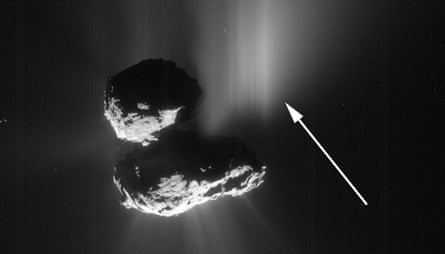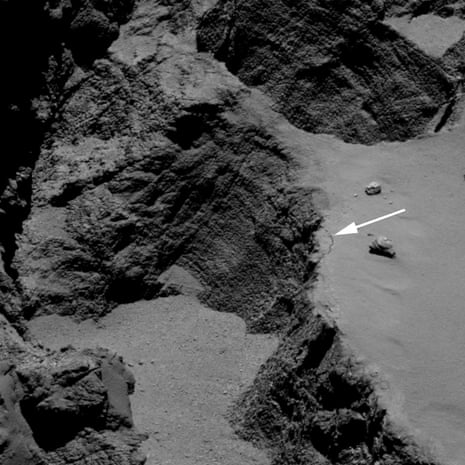A landslide on a comet has been documented by astronomers for the first time in images that reveal the dramatic collapse of a 100 metre-long cliff.
The observations by the Rosetta spacecraft of the comet 67P/Churyumov–Gerasimenko, provide before and after snapshots, which show how the dusty avalanche has left a large patch of pristine ice from the comet’s interior exposed.
Astronomers were also able to link the landslide to a cometary outburst that occurred simultaneously in the same location, suggesting that the plumes of dust and gas typically seen as comets come close to the sun are caused by the crumbling and shifting of surface structures such as mounds or cliffs.
Previously, scientists had speculated that outbursts, which at a glance resemble eruptions of geysers on Earth, were the result of blasts of pressurised gas that had built up in the comet’s interior as it warms.
The latest observations suggest an alternative explanation. The images from the Rosetta craft focus on a cliff, known as Aswan, around the “wing” area of the duck-shaped comet 67P. A snapshot from September 2014 shows a giant fracture, 70 metres-long by one metre-wide, along the top of the cliff.

On 10 July 2015, a separate camera recorded a large plume of dust that could be traced back to the same region of the comet. Five days later, fresh images of Aswan show the cliff had collapsed, suggesting that the outburst was the direct result of the landslide.
“This is the most compelling evidence that we have that the observed outburst was directly linked to the collapse of the cliff,” said Maurizio Pajola, an astronomer at the Nasa Ames Research Center, California, and the study’s lead author.
The study, published in the journal Nature Astronomy, also simulated conditions at the surface of 67P at the time of the event. At the Aswan cliff site in July 2015, temperatures would have risen from -143C to around 46C in just 20 minutes as the surface came out of shadow into direct sunlight. The cliff was directly illuminated for around 1.5 hours every 12 hours, creating intense temperature gradients that would have accelerated the emergence of fractures in the comet’s surface.
The Rosetta mission came to an end in September after more than 12 years of spaceflight and two years spent in orbit about comet 67P. In November 2014, the Rosetta mother ship dropped a small robotic lander, called Philae, on to the surface of the comet to collect high resolution images and take measurements of the surface conditions.

Comments (…)
Sign in or create your Guardian account to join the discussion